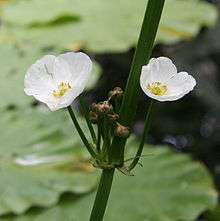Echinodorus subalatus
Echinodorus subalatus is a species of aquatic plants in the Alismataceae. It is native to Cuba, Mexico, Central America, Guyana, Venezuela, Bolivia, Brazil and Paraguay.[1] It is found naturally growing in mud by the side of streams.
| Echinodorus subalatus | |
|---|---|
 | |
| Scientific classification | |
| Kingdom: | Plantae |
| Clade: | Tracheophytes |
| Clade: | Angiosperms |
| Clade: | Monocots |
| Order: | Alismatales |
| Family: | Alismataceae |
| Genus: | Echinodorus |
| Species: | E. subalatus |
| Binomial name | |
| Echinodorus subalatus (Mart.) Griseb. | |
| Synonyms[1] | |
| |
| Wikimedia Commons has media related to Echinodorus subalatus. |
Description
Leaves with canaliculate petioles, blades lanceolate, narrowly to broadly ovate, sharp on the tip, decumbent or rarely abrupt on the base, 18 – 24 cm long x 2 – 9 cm wide, with terrestrial forms usually only 10 x 2 cm having 5 - 7 veins and distinct pellucid lines.
Stem below cylindrical, between whorls triangular in cross-section, often alate, 35 – 120 cm long. Inflorescence racemose or paniculate having 4 - 15 whorls. Bracts on base connate, longer than the pedicels (up to 3.5 cm). Pedicels 0.5 – 2 cm long. Sepals 4 – 6 mm long, petals about twice as long, the diameter of the corolla 1.2 - 1.5 cm. Usually 12 stamens, achenes 2 x 1.5 mm with one, rarely 2 glands separated by a rib. Stylar beak bent back - reaching usually 1/4 of the body.[2][3][4][5][6][7]
Vegetatively, resembles E. andrieuxii, nut differs by having distinct pellucid lines, a usually paniculate inflorescence and by achenes with beaks that are at most 1/3 as long as the body.
Cultivation
Deep, rich growing substrate and a good light. Will grow submersed or emersed. Benefits from additional CO2.[8]
References
- "World Checklist of Selected Plant Families: Royal Botanic Gardens, Kew". apps.kew.org. Retrieved 2017-01-28.
- A., Grisebach (1866-01-01). "Catalogus plantarum cubensium exhibens collectionem Wrightianam aliasque minores ex insula Cuba missas". Cite journal requires
|journal=(help) - von, Linné, Carl; J., Römer, J.; August, Schultes, Joseph; Hermann, Schultes, Julius; Joachim, Sprengel, Kurt Polycarp; G., Cotta, J. (1830-01-01). "Caroli a Linné ... Systema vegetabilium". v.7, pt.2. Cite journal requires
|journal=(help) - CONABIO. 2009. Catálogo taxonómico de especies de México. 1. In Capital Nat. México. CONABIO, Mexico City.
- CROW, G. E. 2003. Alismataceae. In: Manual de Plantas de Costa Rica, B.E. Hammel, M.H. Grayum, C. Herrera & N. Zamora (eds.). Monographs in systematic botany from the Missouri Botanical Garden92: 35–42.
- Davidse, G., M. Sousa Sánchez & A.O. Chater. 1994. Alismataceae a Cyperaceae. 6: i–xvi, 1–543. In G. Davidse, M. Sousa Sánchez & A.O. Chater (eds.) Flora Mesoamericana. Universidad Nacional Autónoma de México, México, D. F.
- Haynes, R. R. & L.B. Holm-Nielsen. 1994. The Alismataceae. Flora Neotropica 64: 1–112.
- K. Rataj in Petfish Monthly, December 1976.